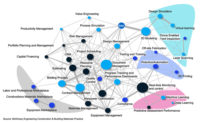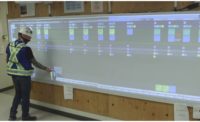Getting the most out of digital twins, where 3D models of building structures and infrastructure are directly linked to sensor and field data from the real world, can be a strain on computer power and network traffic.
Taking steps to relieve the data logjam, Bentley Systems took the first day of its annual Year in Infrastructure conference to announce a strategic partnership with Microsoft to better integrate the tech giant’s Azure cloud system into Bentley’s software, expanding its capabilities.
"The events of 2020 have only heightened the need for greater digitization of infrastructure asset management,” said Microsoft CEO Satya Nadella during the YII opening keynote on Oct. 20 with Bentley Systems CEO Greg Bentley. “What this pandemic has taught us is that the digital infrastructure investments cities have made have been key to continuous operation. Just to be in business, they need digital infrastructure and digital twins. We can't predict what the next event is going to be.”
The new partnership will build upon the existing work Microsoft has already done in building out its Azure cloud-based platform to manage large amounts of incoming sensor and reality capture data that cities and municipalities collect. New integrations will allow for Bentley Systems’ digital twin software environment to sit on top of that Azure foundation, greatly increasing both the computing power and data throughput the system can handle.
“We had Azure as a basic cloud infrastructure, but built on top of that was an IoT [Internet of Things] service,” says Tony Shakib, Microsoft general manager and partner for Microsoft Azure IoT. “The new innovation here is the digital twin, a new layer on top of which we can not only manage [IoT] devices but look at the relationships in their [data].”
With Microsoft already looking for new ways to aggregate IoT data coming in from built assets, it was a short hop to integrate with Bentley’s vision for digital twins. “At Bentley we don’t want to do anything we can rely on Microsoft to supply us,” said Greg Bentley in the keynote, noting that the two companies plan to explore co-development of future software products. “We absolutely want to partner shoulder-to-shoulder—not only a technology partnership but in going to market as well.”
While Bentley has been advocating for digital twins in construction for years, new advancements are bringing the technology to an inflection point, says Ken Adamson, Bentley Systems vice president for design integration. “A rapid convergence of technology has changed the way we work through digital twins,” he says. Full cloud integration for digital twins has allowed the same twin to be accessed from a range of Bentley’s desktop and mobile applications, and with the live data coming in from the assets in near-real time.
Shakib says that not only will Bentley digital twins see their IoT data coming in at a much faster pace, cities, municipalities and other owners of infrastructure assets will be able to get Bentley digital twins as an extension of their Azure subscriptions. “They’re be able to access that same data to drive the applications Bentley provides. They don’t have to move the data around,” he adds.
Transforming Transit With Digital Twins
Steve Cockerell, Bentley Systems industry marketing director, rail and transit, noted in his YII presentation that digital twin technology can inform transportation projects not only in terms of cost, scheduling and planning but also regarding carbon footprint. For the HS2 project in the U.K., teams are “pricing the work and planning the work in terms of pounds, and also in terms of cost of CO2,” he said. “By using the digital twin, they’re able to adjust their methods, and perhaps schedules or order in which they’re doing things.”
Bentley announced the release of OpenGround, a cloud-based tool that integrates data on geotechnical conditions into its suite of civil design and analysis tools. The tool evolved out of Bentley’s acquisition last year of Keynetix. Another newly released transportation tool is Overhead Line Designer. Developed jointly by Bentley Systems and Siemens Mobility, Overhead Line Designer addresses the design, construction and lifecycle of rail catenary systems.
Cockerell noted that the “Bentley Has Your Back” campaign in response to COVID-19 includes waived fees through November for users of OpenBuilding and the LEGION simulator, which simulates pedestrian flows through stations and can look at how social distancing affects those flows.
Francois Valois, Bentley vice president of civil engineering, noted that the New York State Dept. of Transportation utilized OpenRoad and OpenBridge to solicit bids in its first-ever model-based contracting project, Route 20. The process allowed the agency to save almost 400 sheets of paper, 15% off design time and attracted just as many bidders as a conventional process. This process “is still in the early stage of adoption because a lot of people are still attached to plans…but a hybrid workflow is common now,” Valois says. “Especially now that we are socially distanced.”
Dan Vogen, Bentley vice president of road and rail asset management, noted that the Federal Highway Administration is in the process of changing its national bridge inspection standard. Rather than requiring state DOTs to inspect every bridge every two years, the new specification, expected early next year, will be performance-based. Regarding bridge inspection technology, “we are building in all the requirements needed to be compliant with the new spec,” he says.
With digital twins of bridges, bridge inspectors have said they can do 90% of what they used to do in the field in the office beforehand, Vogen said in the media briefing. Drones and augmented-reality headsets such as Microsoft Hololens can give inspectors a 3D geometric representation of bridge conditions rather than looking at photos taken from various angles at various points in time, spotting some problems without even going to the site.







Post a comment to this article
Report Abusive Comment